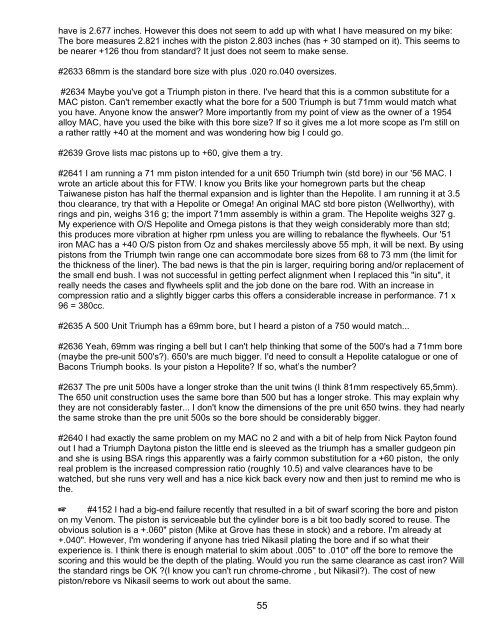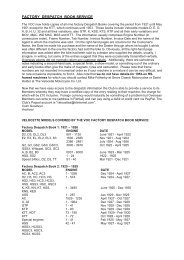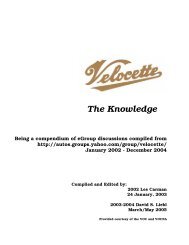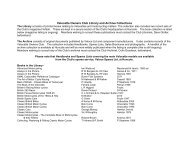The Knowledge - Velocette Owners Club
The Knowledge - Velocette Owners Club
The Knowledge - Velocette Owners Club
You also want an ePaper? Increase the reach of your titles
YUMPU automatically turns print PDFs into web optimized ePapers that Google loves.
have is 2.677 inches. However this does not seem to add up with what I have measured on my bike:<br />
<strong>The</strong> bore measures 2.821 inches with the piston 2.803 inches (has + 30 stamped on it). This seems to<br />
be nearer +126 thou from standard? It just does not seem to make sense.<br />
#2633 68mm is the standard bore size with plus .020 ro.040 oversizes.<br />
#2634 Maybe you've got a Triumph piston in there. I've heard that this is a common substitute for a<br />
MAC piston. Can't remember exactly what the bore for a 500 Triumph is but 71mm would match what<br />
you have. Anyone know the answer? More importantly from my point of view as the owner of a 1954<br />
alloy MAC, have you used the bike with this bore size? If so it gives me a lot more scope as I'm still on<br />
a rather rattly +40 at the moment and was wondering how big I could go.<br />
#2639 Grove lists mac pistons up to +60, give them a try.<br />
#2641 I am running a 71 mm piston intended for a unit 650 Triumph twin (std bore) in our '56 MAC. I<br />
wrote an article about this for FTW. I know you Brits like your homegrown parts but the cheap<br />
Taiwanese piston has half the thermal expansion and is lighter than the Hepolite. I am running it at 3.5<br />
thou clearance, try that with a Hepolite or Omega! An original MAC std bore piston (Wellworthy), with<br />
rings and pin, weighs 316 g; the import 71mm assembly is within a gram. <strong>The</strong> Hepolite weighs 327 g.<br />
My experience with O/S Hepolite and Omega pistons is that they weigh considerably more than std;<br />
this produces more vibration at higher rpm unless you are willing to rebalance the flywheels. Our '51<br />
iron MAC has a +40 O/S piston from Oz and shakes mercilessly above 55 mph, it will be next. By using<br />
pistons from the Triumph twin range one can accommodate bore sizes from 68 to 73 mm (the limit for<br />
the thickness of the liner). <strong>The</strong> bad news is that the pin is larger, requiring boring and/or replacement of<br />
the small end bush. I was not successful in getting perfect alignment when I replaced this "in situ", it<br />
really needs the cases and flywheels split and the job done on the bare rod. With an increase in<br />
compression ratio and a slightly bigger carbs this offers a considerable increase in performance. 71 x<br />
96 = 380cc.<br />
#2635 A 500 Unit Triumph has a 69mm bore, but I heard a piston of a 750 would match...<br />
#2636 Yeah, 69mm was ringing a bell but I can't help thinking that some of the 500's had a 71mm bore<br />
(maybe the pre-unit 500's?). 650's are much bigger. I'd need to consult a Hepolite catalogue or one of<br />
Bacons Triumph books. Is your piston a Hepolite? If so, what’s the number?<br />
#2637 <strong>The</strong> pre unit 500s have a longer stroke than the unit twins (I think 81mm respectively 65,5mm).<br />
<strong>The</strong> 650 unit construction uses the same bore than 500 but has a longer stroke. This may explain why<br />
they are not considerably faster... I don't know the dimensions of the pre unit 650 twins. they had nearly<br />
the same stroke than the pre unit 500s so the bore should be considerably bigger.<br />
#2640 I had exactly the same problem on my MAC no 2 and with a bit of help from Nick Payton found<br />
out I had a Triumph Daytona piston the little end is sleeved as the triumph has a smaller gudgeon pin<br />
and she is using BSA rings this apparently was a fairly common substitution for a +60 piston, the only<br />
real problem is the increased compression ratio (roughly 10.5) and valve clearances have to be<br />
watched, but she runs very well and has a nice kick back every now and then just to remind me who is<br />
the.<br />
L #4152 I had a big-end failure recently that resulted in a bit of swarf scoring the bore and piston<br />
on my Venom. <strong>The</strong> piston is serviceable but the cylinder bore is a bit too badly scored to reuse. <strong>The</strong><br />
obvious solution is a +.060" piston (Mike at Grove has these in stock) and a rebore. I'm already at<br />
+.040". However, I'm wondering if anyone has tried Nikasil plating the bore and if so what their<br />
experience is. I think there is enough material to skim about .005" to .010" off the bore to remove the<br />
scoring and this would be the depth of the plating. Would you run the same clearance as cast iron? Will<br />
the standard rings be OK ?(I know you can't run chrome-chrome , but Nikasil?). <strong>The</strong> cost of new<br />
piston/rebore vs Nikasil seems to work out about the same.<br />
55





